Why Quilts Matter – Question & Answer with Caryl Bryer Fallert, Part 2
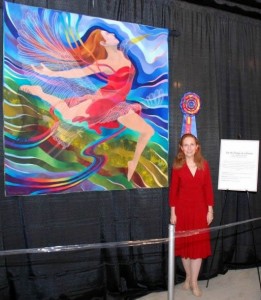
On the Wings of a Dream – Caryl Bryer Fallert-Gentry (photo by Shawn Quinlan)
In part one of our Q&A, Caryl Bryer Fallert-Gentry detailed the extensive process of how she conceives and executes a design for a quilt.
Since we are now familiar with how much time, materials, work and effort go in to producing such a work of art, we naturally ask the next question – how does a quilt artist go about pricing her work?
You will be amazed at the level of detail and what you will learn from her extraordinary detailed directives.
You have had commissions for special work for display at corporate offices. As an artist, what considerations come in to play when deciding how much to charge for the work? (Your time, your design, the materials you use, etc.).
Pricing is one of the most difficult decisions we have to make as quilt artists. My own commission work is priced by the square foot. While this seems like a crude way to price the product of your heart and soul, it is a practical way to predict ahead of time what a commission piece might be worth. Since some of my quilts have very complex piecing and others are whole cloth, I have a different square foot price for each different style.
One way to decide on a square foot price is to look at your record of past sales. What has been the average square foot price for work that has already sold in this style? If all of your work is selling as soon as you make it, it may be time to raise your prices.

Kirlian Fields – by Caryl Bryer Fallert-Gentry
Here is my standard answer when quilters with no record of sales ask for some guidelines for pricing their work:
To decide what your square foot price will be, first you need to keep track of your time on at least one quilt in that style. How long did it take to design your quilt and prepare the paper pattern? For me, the design often takes longer than the actual piecing and quilting. How long did it take to piece? How long did it take to baste, quilt, and bind? How long did it take to put your studio back in order after the quilt was finished? Add up all these numbers and divide by the number of square feet in your quilt. That’s how long it takes to make one square foot of quilt in that style.
Now you need to decide how much your time is worth. Minimum wage in Kentucky is $7.25 per hour. This is the rate of pay for unskilled, entry-level jobs. Skilled labor is worth more. What do you hire other people to do? Clean your house? Mow your lawn? Fix the plumbing? Repair appliances? How much do you pay them? Housekeeping services in Kentucky are generally between $15.00-$20.00 per hour. The last time I had my kitchen sink fixed…………(don’t ask!). If I have been asked to do a commission, this is skilled labor.
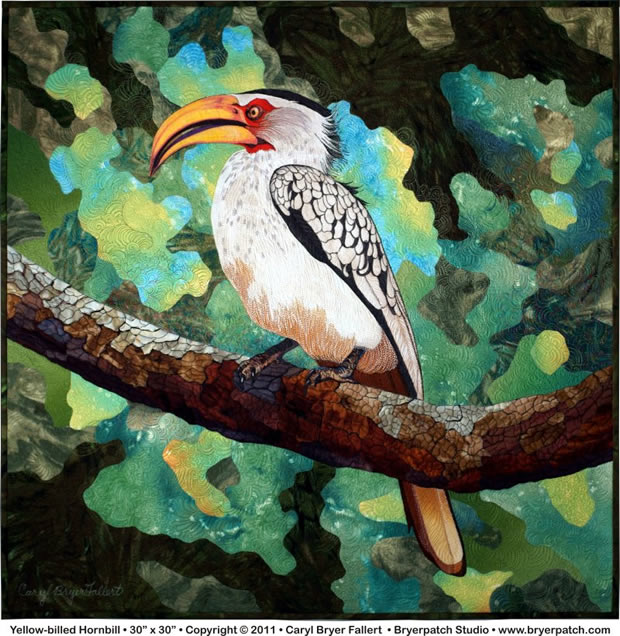
Once you have decided on a number for your hourly rate of pay, you need to multiply that by the number of hours it will take to make your quilt. A 40″ x 60″ quilt, for instance is 16.66 square feet. Suppose you are really speedy and you can actually design, piece, quilt, and bind a square foot of quilt in 2 hours. Your quilt will take 33.32 hours to finish. Now suppose, hypothetically, that your time is worth a mere $15.00 per hour. The figure you start with in figuring your price will be $15 x 33.32 or $499.80.
That’s just the starting figure. Are you are working with a gallery, agent, designer, or architect, or do you plan to work with gallery in the future? They are going to want a commission. They have, hopefully, done some the marketing, interaction with the client, and accounting for you, and they expect to be paid for their time. If it’s a gallery, they will usually expect to be paid 50% – 60% of the selling price. If you need to be paid $499.80 for the quilt, so that means the gallery’s client needs to pay at least $999.60 for the quilt. If you have found your own client and done your own marketing, accounting, and client interaction, then you need to pay yourself for all of these things. If you ever plan to work with an agent or gallery, you need to plan ahead and set your prices accordingly.
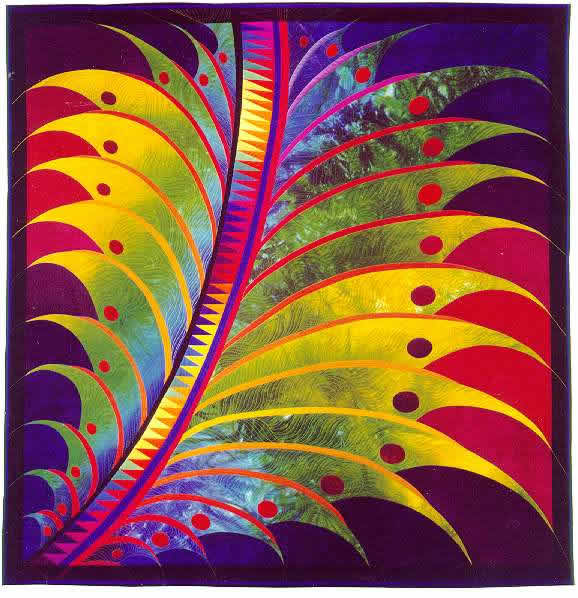
Feather Study 9 – by Caryl Bryer Fallert-Gentry
Now you probably are going to want to document this quilt by taking photographs and writing an artist’s statement for your client. How long will that take? Another hour if you are really speedy, and it usually takes longer. Pay yourself and your agent each another $15.00. So now the price of the quilt is up to $1,029.60. Does the client expect you to come to their home or business and install the quilt? How long will it take to drive there and back – one hour? How long will it take to install it? (Another hour?) Do you have to purchase special rods to hang the quilt? Add $15.00). How long does it take to cut, sand, paint, and drill the rods – add another $15.00. How much did you pay for the sand paper, drill bit, paint, and saw? (Add another $5.00-, you can’t expense it all out on this one quilt.) Do you need special equipment to hang the quilt? Does the client want the quilt to be sprayed with UV protection? Of course you have to double all these cost numbers, because your agent is going to take half.
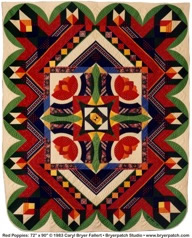
Red Poppies (1983) – by Caryl Bryer Fallert-Gentry
Finally, because you work faster than most of us and are willing to work for less than you pay for other professional services, you can sell your quilt for $1,189.60 (let’s round that up to an even $1,200.00). Remember this is hypothetical, and I hope you will pay yourself more than $15.00 an hour for your labor.
A final note – if you are doing corporate commissions, keep in mind that companies, even really big companies, are bought and sold all of the time. Don’t get too attached to the work, or have a clause in your contract specifying that you will have first right of refusal if the work is to be sold. In 1993, the General Railway Signal Corporation commissioned me to make a large triptych for the lobby of their huge new corporate headquarters in Rochester, New York, for which they paid me thousands of dollars. Ten years later I learned the company that bought them out had auctioned their entire art collection on eBay. The triptych was split up and auctioned on eBay to two different collectors – for a fraction of what it was worth.
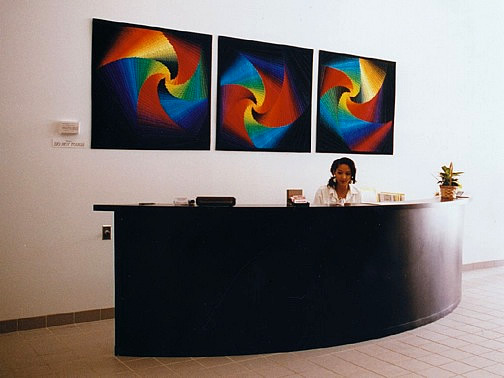
Refraction 8901 installation – by Caryl Bryer Fallert-Gentry
More About Caryl Bryer Fallert-Gentry
Visit Caryl’s webpage, Breyerpatch Studio, for a full schedule of exhibits, her gallery, and more information on where to buy her beautiful fabric. For tips on photographing quilts and more information about pricing, dyeing, painting and caring for quilts, visit Caryl’s Frequently Asked Questions page.
All images in this post are courtesy of Caryl Bryer Fallert-Gentry.



Caryl thanks for the excellent information. I love your yellow billed hornbill. quilt piece. Thanks for sharing your talent.
[…] https://www.whyquiltsmatter.org/staging20231003/discussion-guide-qa-with/quilts-matter-question-answer-caryl-… […]